| Other decades |
| 1330s | 1340s | 1350s | 1360s | 1370s |
Events from the 1350s in England .
| Other decades |
| 1330s | 1340s | 1350s | 1360s | 1370s |
Events from the 1350s in England .
The 1350s was a decade of the Julian Calendar which began on January 1, 1350, and ended on December 31, 1359.
Year 1351 (MCCCLI) was a common year starting on Saturday of the Julian calendar.

Philip VI, called the Fortunate and of Valois, was the first king of France from the House of Valois, reigning from 1328 until his death in 1350.
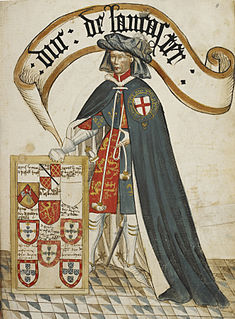
Henry of Grosmont, 1st Duke of Lancaster was an English statesman, diplomat, soldier, and Christian writer. The owner of Bolingbroke Castle in Lincolnshire, Grosmont was a member of the House of Plantagenet, which was ruling over England at that time. He was the wealthiest and most powerful peer of the realm.

The first phase of the Hundred Years' War between France and England lasted from 1337 to 1360. It is sometimes referred to as the Edwardian War because it was initiated by King Edward III of England, who claimed the French throne in defiance of King Philip VI of France. The dynastic conflict was caused by disputes over the French feudal sovereignty over Aquitaine and the English claims over the French royal title. The Kingdom of England and its allies dominated this phase of the war.
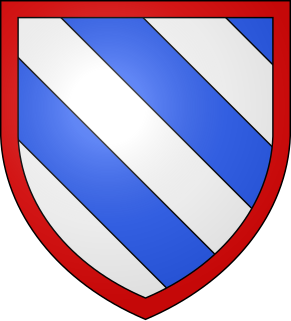
Arnoul d'Audrehem was a Marshal of France, who fought in the Hundred Years' War.
The Battle of Saintes was fought on 1 April 1351 during the Hundred Years' War between French and English forces. The French were besieging the town of Saint-Jean-d'Angély when an English relief force arrived. The English force was victorious, but the battle was not able to force the end of the siege of Saint-Jean-d'Angély, which fell to the French on 31 August.
This is a timeline of the Hundred Years' War between England and France from 1337 to 1453 as well as some of the events leading up to the war.
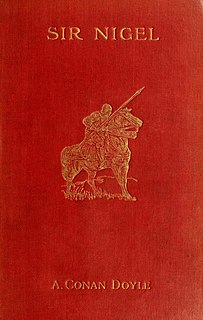
Sir Nigel is a historical novel set during the early phase of the Hundred Years' War, spanning the years 1350 to 1356. It was written by British author Sir Arthur Conan Doyle, first published in serial form during 1905–06 where it was illustrated by Joseph Clement Coll. It was illustrated by The Kinneys and Arthur Twidle in its book editions. It is the background story to Doyle's earlier novel The White Company (1891), and describes the early life of that book's hero, Nigel Loring, a knight in the service of King Edward III in the first phase of the Hundred Years' War. The character is loosely based on the historical knight Neil Loring.
Events from the 1340s in England

John de Lisle, 2nd Baron Lisle of Rougemont, KG was an English peer and soldier who spent much of his career serving in the wars in France. He was a companion of Edward III, and one of the founding members of the Order of the Garter in 1348.
Events from the 1360s in England.

The Hundred Years' War was a series of armed conflicts between the kingdoms of England and France during the Late Middle Ages. It originated from disputed claims to the French throne between the English royal House of Plantagenet and the French royal House of Valois. Over time, the war grew into a broader power struggle involving factions from across Western Europe, fuelled by emerging nationalism on both sides.
The Truce of Calais was a truce agreed by King Edward III of England and King Philip VI of France on 28 September 1347, which was mediated by emissaries of Pope Clement VI. The Hundred Years' War had broken out in 1337 and in 1346 Edward had landed with an army in northern France. After inflicting a heavy defeat on Philip and a French army at the Battle of Crécy the English besieged Calais, which fell after 11 months. Both countries were financially and militarily exhausted and two cardinals acting for Pope Clement were able to broker a truce in a series of negotiations outside Calais. This was signed on 28 September to run until 7 July 1348.
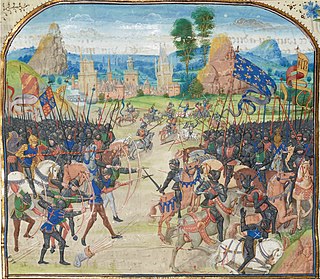
The Black Prince's chevauchée of 1356 was a large-scale mounted raid by an Anglo-Gascon force under the command of Edward, the Black Prince, between 4 August and 2 October 1356 as a part of the Hundred Years' War. The war had broken out in 1337, but a truce and the ravages of the Black Death had restricted the extent of the fighting since 1347. In 1355 the French king, John II, determined to resume full-scale war. That autumn, while Edward III of England threatened northern France, his son, Edward of Woodstock, later known as the Black Prince, carried out a devastating mounted raid, or chevauchée: an Anglo-Gascon army marched from the English possession of Gascony 675 miles (1,086 km) to Narbonne and back. The French refused battle, despite suffering enormous economic damage.
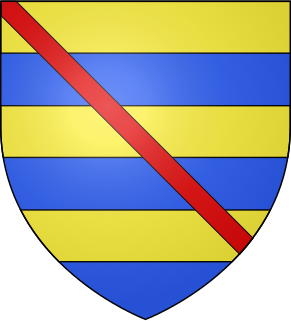
Sir Walter Bentley was an English knight who fought during the Hundred Year's War.
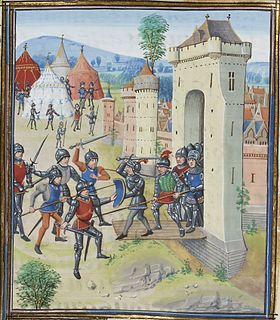
The Black Prince's chevauchée, also known as the grande chevauchée, was a large-scale mounted raid carried out by an Anglo-Gascon force under the command of Edward, the Black Prince, between 5 October and 2 December, 1355 as a part of the Hundred Years' War. John, Count of Armagnac, who commanded the local French forces, avoided battle, and there was little fighting during the campaign.
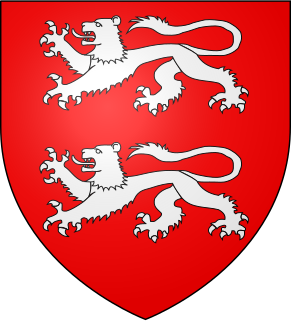
Raoul de Caours was a Breton knight who served both the English and French during the Hundred Years' War.
The Treaty of Guînes was a draft settlement to end the Hundred Years' War, negotiated between England and France and signed at Guînes on 6 April 1354. The war had broken out in 1337 and was further aggravated in 1340 when the English king, Edward III, claimed the French throne. The war went badly for France: the French army was heavily defeated at the Battle of Crécy, and the French town of Calais was besieged and captured. With both sides exhausted, a truce was agreed that, despite being only fitfully observed, was repeatedly renewed.

The siege of Breteuil was the investment of the Norman town of Breteuil, held by partisans of Charles II, King of Navarre, by French forces. It lasted from April to about 20 August 1356. It was interrupted on 5 July when a small English army commanded by Henry, Earl of Lancaster relieved and resupplied it. The French king, John II, attempted to bring Lancaster to battle with the much larger French royal army, but Lancaster marched away and the attempt failed. John then renewed the siege of Breteuil.